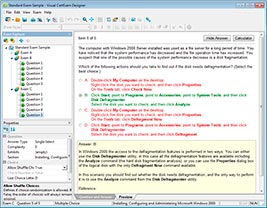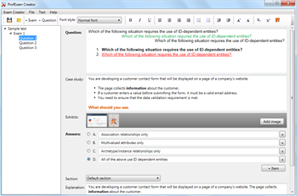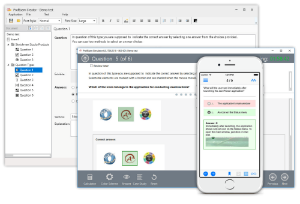Download Certified Advanced Administrator.Certified-Advanced-Administrator.VCEplus.2025-03-31.150q.vcex
| Vendor: | Salesforce |
| Exam Code: | Certified-Advanced-Administrator |
| Exam Name: | Certified Advanced Administrator |
| Date: | Mar 31, 2025 |
| File Size: | 136 KB |
How to open VCEX files?
Files with VCEX extension can be opened by ProfExam Simulator.
Purchase
Coupon: TAURUSSIM_20OFF
Discount: 20%
Demo Questions
Question 1
The administrator at Universal Containers does a soft launch of the Salesforce Authenticator app and allows users to optionally use it to log in. The administrator would now like to look at how many users have successfully used it since it was rolled out.
What are two ways the administrator can get this information?
Choose 2 answers
- Run a session setting report, specifying login methods by user.
- Open the Login Access Policies in Setup which shows how many users are using MFA.
- Create a new view in Identity Verification History, specifying Method.
- The order of flow execution is unpredictabl
Correct answer: AC
Explanation:
Salesforce Authenticator is an app that allows users to verify their identity when logging in to Salesforce using two-factor authentication (2FA). 2FA adds an extra layer of security by requiring users to enter a verification code or approve a notification on their mobile device after entering their username and password.To look at how many users have successfully used Salesforce Authenticator since it was rolled out, an administrator can use two ways:A) Run a session setting report, specifying login methods by user.A session setting report is a report that shows information about users' login sessions, such as login time, location, IP address, browser, platform, etc. A session setting report can also show the login methods used by users, such as password, verification code, or notification. By running a session setting report, specifying login methods by user, an administrator can see how many users have used Salesforce Authenticator to log in to Salesforce.Reference: https://help.salesforce.com/s/articleView?id=sf.reports_session.htm&type=5C) Create a new view in Identity Verification History, specifying Method.Identity Verification History is a page that shows the history of identity verification attempts for each user in the org. Identity verification history includes information such as date, time, status, method, and IP address of each attempt. By creating a new view in Identity Verification History, specifying Method as a filter criterion, an administrator can see how many users have used Salesforce Authenticator to verify their identity when logging in to Salesforce. Reference: https://help.salesforce.com/s/articleView?id=sf.identity_verification_history.htm&type=5 Salesforce Authenticator is an app that allows users to verify their identity when logging in to Salesforce using two-factor authentication (2FA). 2FA adds an extra layer of security by requiring users to enter a verification code or approve a notification on their mobile device after entering their username and password.
To look at how many users have successfully used Salesforce Authenticator since it was rolled out, an administrator can use two ways:
A) Run a session setting report, specifying login methods by user.
A session setting report is a report that shows information about users' login sessions, such as login time, location, IP address, browser, platform, etc. A session setting report can also show the login methods used by users, such as password, verification code, or notification. By running a session setting report, specifying login methods by user, an administrator can see how many users have used Salesforce Authenticator to log in to Salesforce.
Reference: https://help.salesforce.com/s/articleView?id=sf.reports_session.htm&type=5
C) Create a new view in Identity Verification History, specifying Method.
Identity Verification History is a page that shows the history of identity verification attempts for each user in the org. Identity verification history includes information such as date, time, status, method, and IP address of each attempt. By creating a new view in Identity Verification History, specifying Method as a filter criterion, an administrator can see how many users have used Salesforce Authenticator to verify their identity when logging in to Salesforce.
Reference: https://help.salesforce.com/s/articleView?id=sf.identity_verification_history.htm&type=5
Question 2
What should the administrator consider before enabling Person Accounts?
- Person Account cannot be disabled.
- Person Account requires less data storage.
- Person Account and Business Accounts cannot be in the same sharing model.
- All standard Account news can be converted to Person Account field.
Correct answer: A
Explanation:
Person Account cannot be disabled is something that the administrator should consider before enabling Person Accounts. Person Accounts are a special type of accounts that allow storing information about individual people who are not associated with an organization or business account. Once Person Accounts are enabled, they cannot be disabled or removed from the org without contacting Salesforce support Person Account cannot be disabled is something that the administrator should consider before enabling Person Accounts. Person Accounts are a special type of accounts that allow storing information about individual people who are not associated with an organization or business account. Once Person Accounts are enabled, they cannot be disabled or removed from the org without contacting Salesforce support
Question 3
Users at Ursa Major Solar want to create complex dashboards with supporting charts based on data to come from a variety of sources, some of which live on the Internal company shared drives. Which product should the administrator recommend to meet the users' needs?
- Lightning Dashboard Builder
- Report Bulkier
- List views
- Tableau CRM
Correct answer: D
Explanation:
Tableau CRM is a product that allows users to create complex dashboards with supporting charts based on data from a variety of sources, some of which live on internal company shared drives. Tableau CRM can connect to external data sources using connectors or dataflows and store the data in datasets within Salesforce. Tableau CRM can also use artificial intelligence and machine learning to provide insights and recommendations based on the data Tableau CRM is a product that allows users to create complex dashboards with supporting charts based on data from a variety of sources, some of which live on internal company shared drives. Tableau CRM can connect to external data sources using connectors or dataflows and store the data in datasets within Salesforce. Tableau CRM can also use artificial intelligence and machine learning to provide insights and recommendations based on the data
Question 4
Management at Ursa Major Solar wants to understand how many accounts have opportunities in the overall pipeline.
What should the administrator use to create a report showing all open opportunities and the total number of accounts represented?
- The row count on a summary report grouped by account name
- A Cross Filter selecting opportunities with accounts
- A custom report type showing opportunities with accounts
- The Show Unique Count option on the account name column
Correct answer: D
Explanation:
The Show Unique Count option on the account name column will create a report showing all open opportunities and the total number of accounts represented. This option will count each account only once, even if it has multiple opportunities. The report can be grouped by account name or any other field to show more details.Reference: https://help.salesforce.com/s/articleView?id=sf.reports_builder_unique_count.htm&type=5 The Show Unique Count option on the account name column will create a report showing all open opportunities and the total number of accounts represented. This option will count each account only once, even if it has multiple opportunities. The report can be grouped by account name or any other field to show more details.
Reference: https://help.salesforce.com/s/articleView?id=sf.reports_builder_unique_count.htm&type=5
Question 5
Ursa Major Solar has a junction object that connects Docs with Solar Panels. The administrator needs users to be able to see all the solar panels that a Dot is related to. Users already have access to the Bot and the Junction, but not the Solar Panel object.
What access docs the user need to be able to see the solar panel records?
- Read permission is required on both master records.
- Access permission Is not required on either master record.
- Create permission Is required on both master records.
- Read permission is required on at least are master record.
Correct answer: D
Explanation:
Read permission is required on at least one master record to be able to see the solar panel records. Since Item is a junction object between Doc and Solar Panel, users need to have access to either Doc or Solar Panel to see Item records. If users have access to both Doc and Solar Panel, they can see all Item records related to either object.Reference: https://help.salesforce.com/s/articleView?id=sf.relationships_manytomany.htm&type=5 Read permission is required on at least one master record to be able to see the solar panel records. Since Item is a junction object between Doc and Solar Panel, users need to have access to either Doc or Solar Panel to see Item records. If users have access to both Doc and Solar Panel, they can see all Item records related to either object.
Reference: https://help.salesforce.com/s/articleView?id=sf.relationships_manytomany.htm&type=5
Question 6
AW Computing created new multi-tier service plans. The primary difference between the packages Is the length of the term. The company wants to capture start and end dates for each service plan sold, which can direr from the contract dates of the subscription.
How should an administrator ensure the data is captured properly?
- Build a validation rule on the Opportunity object to require custom date fields based on the product(s) selected.
- Configure formula fields to reflect the close date of the opportunity.
- Create a new price book for service plans with term lengths.
- Make a validation rule on the Opportunity Product object to require custom date fields based on the product family.
Correct answer: D
Explanation:
A validation rule on the Opportunity Product object to require custom date fields based on the product family will ensure that the data is captured properly. A validation rule can check if the product family matches the service plan and if so, require the start and end date fields to be filled out. This way, AW Computing can capture the term length for each service plan sold.Reference: https://help.salesforce.com/s/articleView?id=sf.fields_about_validation_rules.htm&type=5 A validation rule on the Opportunity Product object to require custom date fields based on the product family will ensure that the data is captured properly. A validation rule can check if the product family matches the service plan and if so, require the start and end date fields to be filled out. This way, AW Computing can capture the term length for each service plan sold.
Reference: https://help.salesforce.com/s/articleView?id=sf.fields_about_validation_rules.htm&type=5
Question 7
An administrator needs to Import a large amount of historical data (more than 100,000 records) from another system.
Нow should the administrator import the data?
- SOAP based API with Developer console
- Data Loader with Bulk API Enabled
- An AppExchange package
- Import Wizard with Add Only
Correct answer: B
Explanation:
Data Loader with Bulk API Enabled is a tool that can import a large amount of historical data (more than 100,000 records) from another system. Data Loader can insert, update, delete, or export Salesforce records. Bulk API is an API that allows fast and parallel processing of large batches of records.Reference: https://help.salesforce.com/s/articleView?id=sf.data_loader.htm&type=5 https://help.salesforce.com/s/articleView?id=sf.loader_api.htm&type=5 Data Loader with Bulk API Enabled is a tool that can import a large amount of historical data (more than 100,000 records) from another system. Data Loader can insert, update, delete, or export Salesforce records. Bulk API is an API that allows fast and parallel processing of large batches of records.
Reference:
https://help.salesforce.com/s/articleView?id=sf.data_loader.htm&type=5
https://help.salesforce.com/s/articleView?id=sf.loader_api.htm&type=5
Question 8
AW Computing created new multi-tier service plans. The primary difference between the packages Is the length of the term. The company wants to capture start and end dates for each service plan sold, which can direr from the contract dates of the subscription.
How should an administrator ensure the data is captured properly?
- Build a validation rule on the Opportunity object to require custom date fields based on the product(s) selected.
- Configure formula fields to reflect the close date of the opportunity.
- Create a new price book for service plans with term lengths.
- Make a validation rule on the Opportunity Product object to require custom date fields based on the product family.
Correct answer: D
Explanation:
Make a validation rule on the Opportunity Product object to require custom date fields based on the product family is how the administrator should ensure the data is captured properly. A validation rule is a way to enforce data quality and integrity Make a validation rule on the Opportunity Product object to require custom date fields based on the product family is how the administrator should ensure the data is captured properly. A validation rule is a way to enforce data quality and integrity
Question 9
How should an administrator ensure the appropriate number of digits are entered Into the custom encrypted field created to capture credit card numbers on the Opportunity object?
- Use the credit card number mask type.
- Define the number of mask characters.
- Enter the number of digits at the field level.
- Create a validation rule to ensure the length.
Correct answer: D
Explanation:
A validation rule is a formula that validates the data entered by a user and prevents the record from being saved if the data does not meet certain criteria. In this case, the administrator can create a validation rule to ensure that the custom encrypted field for credit card numbers has exactly 16 digits. The other options are not applicable for encrypted fields.Reference: https://help.salesforce.com/s/articleView?id=sf.fields_about_encrypted_fields.htm&type=5 https://help.salesforce.com/s/articleView?id=sf.validation_rules.htm&type=5 A validation rule is a formula that validates the data entered by a user and prevents the record from being saved if the data does not meet certain criteria. In this case, the administrator can create a validation rule to ensure that the custom encrypted field for credit card numbers has exactly 16 digits. The other options are not applicable for encrypted fields.
Reference:
https://help.salesforce.com/s/articleView?id=sf.fields_about_encrypted_fields.htm&type=5
https://help.salesforce.com/s/articleView?id=sf.validation_rules.htm&type=5
Question 10
An administrator is using the Dev Console Log Inspector to troubleshoot a Process Builder.
What event type should the administrator look for in the event column?
- Event types beginning with FLOW
- Event types beginning with AUTOMATED.
- Event types beginning with WORKFLOW
- Event types beginning with PROCESS
Correct answer: A
Explanation:
The Dev Console Log Inspector is a tool that allows you to view and analyze debug logs in a graphical interface. Debug logs contain information about database operations, system processes, and errors that occur when executing a transaction or running unit tests. To troubleshoot a process builder, the administrator should look for event types beginning with FLOW in the event column. These event types indicate the start and end of a flow interview, as well as any flow elements, faults, or decisions that occur during the execution.Reference: https://help.salesforce.com/s/articleView?id=sf.code_dev_console_log_inspector.htm&type=5 https://help.salesforce.com/s/articleView?id=sf.code_debug_log_event_types.htm&type=5 The Dev Console Log Inspector is a tool that allows you to view and analyze debug logs in a graphical interface. Debug logs contain information about database operations, system processes, and errors that occur when executing a transaction or running unit tests. To troubleshoot a process builder, the administrator should look for event types beginning with FLOW in the event column. These event types indicate the start and end of a flow interview, as well as any flow elements, faults, or decisions that occur during the execution.
Reference:
https://help.salesforce.com/s/articleView?id=sf.code_dev_console_log_inspector.htm&type=5
https://help.salesforce.com/s/articleView?id=sf.code_debug_log_event_types.htm&type=5
Question 11
After setting up field history tracking on the Account object, the administrator for AW Computing wants to retrieve the field history data for analysis.
Нow should the administrator acquire this data?
- Create a report of Accounts and export it to Excel.
- Query and export the Account History object using Data Loader.
- Use the Data export service in setup.
- Create a list view of Account History and print using the Printable View action.
Correct answer: B
Explanation:
Query and export the Account History object using Data Loader is how the administrator can acquire the field history data for analysis. Data Loader is a tool that allows administrators to import, export, insert, update, delete, or upsert records in Salesforce using CSV files. Data Loader can handle large data sets and complex data transformations. Data Loader can be used to query and export the Account History object, which stores the field history data for accounts, using SOQL statements. Query and export the Account History object using Data Loader is how the administrator can acquire the field history data for analysis. Data Loader is a tool that allows administrators to import, export, insert, update, delete, or upsert records in Salesforce using CSV files. Data Loader can handle large data sets and complex data transformations. Data Loader can be used to query and export the Account History object, which stores the field history data for accounts, using SOQL statements.
HOW TO OPEN VCE FILES
Use VCE Exam Simulator to open VCE files

HOW TO OPEN VCEX FILES
Use ProfExam Simulator to open VCEX files


ProfExam at a 20% markdown
You have the opportunity to purchase ProfExam at a 20% reduced price
Get Now!



